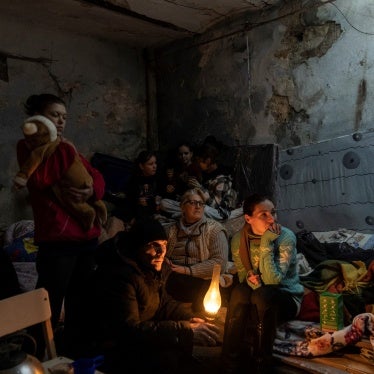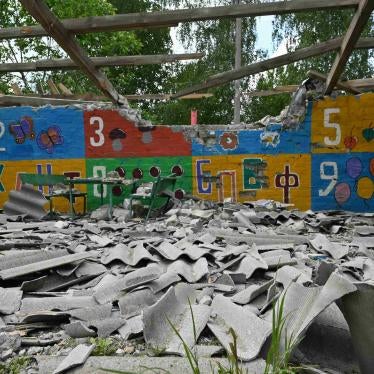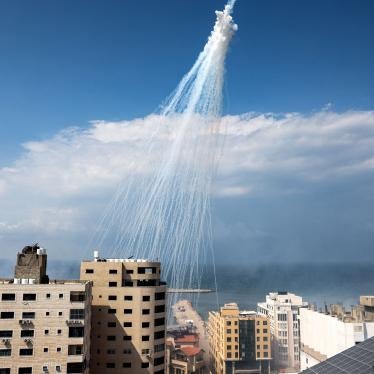- A incursão russa à cidade ucraniana de Mariupol em 2022 deixou milhares de civis mortos e feridos, incluindo muitos em ataques que aparentemente violam o direito internacional, mostram novas descobertas.
- A destruição de Mariupol pelas forças russas e os esforços contínuos para apagar a cultura ucraniana se destacam como um dos piores capítulos da invasão em larga escala da Ucrânia.
- Órgãos internacionais e governos comprometidos com a justiça deveriam se concentrar em investigar altas autoridades russas que possam estar envolvidas em crimes de guerra em Mariupol.
(Kiev, 8 de fevereiro de 2024) – A incursão militar russa à cidade ucraniana de Mariupol entre fevereiro e maio de 2022 deixou milhares de civis mortos e feridos, incluindo muitos em ataques que aparentemente violam o direito internacional, e obrigou centenas de milhares a permanecerem na cidade por semanas sem serviços básicos, disseram hoje a Human Rights Watch, a Truth Hounds e a SITU Research em um relatório com extensas novas descobertas. O presidente russo Vladimir Putin e outras autoridades deveriam ser investigados e processados adequadamente por seu papel em aparentes crimes de guerra cometidos pelas forças russas durante os combates em Mariupol, e a Rússia deveria fornecer reparações às vítimas e seus familiares por violações das leis de guerra.
O relatório de 224 páginas, “‘Our City Was Gone’: Russia’s Devastation of Mariupol, Ukraine,” (“‘Nossa Cidade Desapareceu’: A destruição russa de Mariupol, Ucrânia”), acompanhado de uma publicação digital multimídia e um vídeo de 20 minutos, analisam o sofrimento de civis e os danos a milhares de edifícios, incluindo várias centenas de prédios residenciais, hospitais, instalações educacionais e infraestrutura de eletricidade e água. Os materiais descrevem diversas tentativas de autoridades ucranianas e agências internacionais de organizar evacuações oficiais e entregar ajuda humanitária diante da obstrução russa.
“A destruição de Mariupol pelas forças russas se destaca como um dos piores capítulos da invasão russa em larga escala na Ucrânia”, disse Ida Sawyer, diretora de crises e conflitos da Human Rights Watch. “Organismos internacionais e governos comprometidos com a justiça deveriam se concentrar em investigar as altas autoridades russas que parecem conectadas à supervisão de crimes de guerra nesta cidade outrora vibrante.”
O relatório é baseado em 240 entrevistas realizadas pela Human Rights Watch e Truth Hounds – uma importante organização ucraniana de direitos humanos – com moradores deslocados de Mariupol e uma análise de mais de 850 fotos e vídeos, documentos e dezenas de imagens de satélite obtidos pela Human Rights Watch e SITU Research. A publicação digital multimídia inclui reconstruções em 3D de sete edifícios danificados em ataques que aparentemente violam o direito internacional, gráficos sobre escolas e hospitais danificados e uma análise de cemitérios para ajudar a estimar o número de mortos.
Os grupos documentaram em detalhes 14 ataques que danificaram ou destruíram 18 edifícios, matando e ferindo civis. Eles incluem ataques que atingiram dois hospitais, o teatro da cidade que abrigava civis, um armazém de alimentos, um local de distribuição de ajuda humanitária, um supermercado e edifícios residenciais usados como abrigos. Nestes ataques, a Human Rights Watch e a Truth Hounds ou não encontraram evidências de uma presença militar ucraniana dentro ou perto das estruturas atingidas ou apenas uma presença militar pequena, tornando os ataques aparentemente ilegais.
Em um caso, um homem que ajudou a resgatar sobreviventes e recuperar corpos dos escombros de um edifício residencial atingido em 13 de março de 2022, descreveu o que viu. “O prédio foi simplesmente pulverizado”, disse ele. “Quase nada restou, apenas parte de um banheiro e parte de um corredor... [Um homem ao lado de sua mãe morta] estava coberto de sangue. Ele tinha sangue saindo das orelhas, nariz e olhos, e estava chorando... [Outro homem] estava segurando seu filho sem vida e falando com ele. Ele continuava dizendo: ‘A criança não está chorando’”. O ataque matou oito civis e feriu outros três.
“Apesar dos desafios em investigar crimes de guerra em áreas tornadas inacessíveis pela ocupação russa, nós e nossos parceiros passamos quase dois anos investigando a verdade sobre os horríveis crimes cometidos pelas forças russas em Mariupol”, disse Roman Avramenko, diretor executivo da Truth Hounds. “Esta investigação visa garantir que esses crimes nunca sejam esquecidos e que os perpetradores enfrentem a justiça.”
A análise de imagens de satélite, fotos e vídeos dos principais cemitérios da cidade demonstra que mais de 10.000 pessoas foram enterradas em Mariupol entre março de 2022 e fevereiro de 2023. Comparando o aumento de sepulturas com a taxa de mortalidade normal da cidade, os grupos estimam que pelo menos 8.000 pessoas morreram em decorrência do conflito ou por causas relacionadas à guerra, embora não haja informação de quantas dessas pessoas eram civis.
O número total de mortos pode ser significativamente maior: algumas sepulturas continham vários corpos e os restos mortais de outras pessoas provavelmente foram enterrados nos escombros. Algumas pessoas mortas podem permanecer em sepulturas improvisadas, e outras podem ter morrido mais tarde de causas relacionadas à guerra. Alguns familiares de desaparecidos ainda estão procurando seus entes queridos.
Milhares de pessoas foram feridas, muitas das quais perderam membros, visão, audição ou memória, incluindo por lesões cerebrais traumáticas causadas por explosões.
O relatório identifica 17 unidades militares russas e afiliadas à Rússia que estavam operando em Mariupol em março e abril de 2022, no auge dos combates.
Os grupos também identificaram 10 pessoas que, por uma questão de responsabilidade de comando, podem ser criminalmente responsáveis por crimes de guerra relacionados a ataques ilegais e o possível bloqueio arbitrário de ajuda humanitária e evacuações. Estas pessoas também podem ter cometido crimes de guerra e possíveis crimes contra a humanidade pelo deslocamento forçado de residentes de Mariupol para a Rússia e territórios ocupados pela Rússia. Sob o princípio da responsabilidade de comando, um superior é responsável pelos crimes cometidos por seus subordinados quando sabia ou deveria saber que os crimes estavam sendo cometidos, mas não tomou medidas razoáveis para impedi-los ou puni-los.
Em 4 de dezembro de 2023, a Human Rights Watch enviou ao governo russo um resumo das descobertas do relatório e uma lista de perguntas, mas, até 1º de fevereiro, não havia recebido nenhuma resposta.
Desde a ocupação da cidade, as autoridades russas estão construindo novos edifícios residenciais como parte de seu plano declarado de reconstruir e reurbanizar Mariupol até 2035. Uma potência ocupante deve limpar os escombros e demolir estruturas inseguras para proteger a população. No entanto, na ausência de investigadores independentes, o governo russo está apagando evidências físicas em centenas de potenciais cenas de crime.
As forças ocupantes também estão eliminando características da identidade ucraniana, incluindo a imposição de um currículo escolar russo e mudando o nome de ruas. Eles estão exigindo que os residentes obtenham passaportes russos para se candidatarem a certos empregos e benefícios.
Em Mariupol, como em outros lugares na Ucrânia, as forças russas e afiliadas usaram extensivamente armas explosivas com efeitos de grande área, incluindo bombardeios de tanques e artilharia pesada, lançadores de foguetes de múltiplos canos, mísseis e ataques aéreos em áreas povoadas. O uso desse tipo de armamento em áreas povoadas tem impactos devastadores sobre civis e infraestrutura civil, aumentando as preocupações sobre ataques indiscriminados e desproporcionais, que violam o direito internacional.
“Mariupol se destaca como um testemunho da cruel destruição e sofrimento causados por armas explosivas em cidades e vilas ao redor do mundo”, disse Sawyer. “Todos os governos deveriam apoiar a busca por justiça para os crimes cometidos na Ucrânia e assinar a declaração internacional condenando o uso de armas explosivas em áreas povoadas”.









